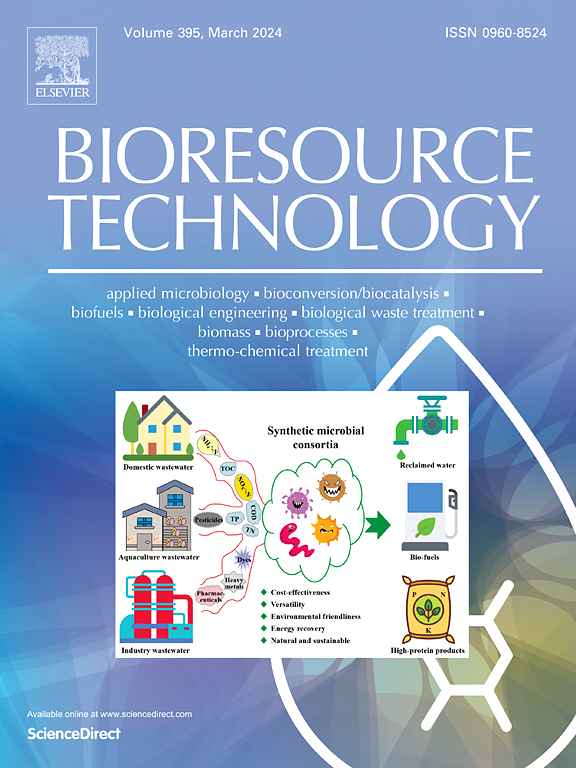Synergistic effects and mechanisms of ultrasonic, pH, and peracetic acid pretreatment on sludge anaerobic fermentation to stimulate short-chain fatty acid production
IF 9.7
1区 环境科学与生态学
Q1 AGRICULTURAL ENGINEERING
引用次数: 0
Abstract
Anaerobic fermentation (AF) for short-chain fatty acid (SCFAs) production from waste-activated sludge (WAS) is a sustainable carbon recovery strategy; however, its efficiency is often constrained by inadequate sludge disintegration. To address this challenge, combined pretreatment methods, including ultrasonic-acidic (US-Ac), ultrasonic-alkali (US-Ak), and ultrasonic-alkali/peracetic acid (US-Ak/PAA) have been proposed as effective solutions. The Results revealed that the US-Ak/PAA pretreatment yielded the highest SCFAs accumulation at 370.5 mg/g VSS at day 6 of AF, surpassing the control, sole PAA, sole pH10, and 0.25US30 reactors by 4.27, 2.7, 2.0, and 1.2-fold, respectively. Furthermore, the US-Ak group (0.25US30) significantly enhanced SCFAs yield by 1.46-fold compared to the US-Ac group (US0.5–30). Mechanistic analysis indicated that the US-Ak/PAA pretreatment effectively disrupted extracellular polymeric substances (EPS), lysed microbial cells, and increased the release of soluble organic matter, thereby optimizing metabolic activity and SCFAs accumulation. The enzymatic activities of protease and α-glucosidase were notably enhanced, demonstrating a strong correlation with improved hydrolysis and acidogenesis processes. Microbial community analysis further revealed that the US-Ak/PAA pretreatment substantially enriched the abundance of hydrolytic and acidogenic bacterial taxa, including Acinetobacter, Petrimonas, Macellibacteroides, Proteiniphilum, Tissierella, and unclassified_c_Clostridia, etc. species. Collectively, the US-Ak/PAA pretreatment strategy not only optimized SCFAs production from WAS but also contributed to mitigating the environmental risks associated with WAS disposal.

超声、pH和过氧乙酸预处理对污泥厌氧发酵刺激短链脂肪酸生成的协同效应及机理
厌氧发酵(AF)生产短链脂肪酸(SCFAs)的废物活性污泥(WAS)是一个可持续的碳回收策略。然而,其效率往往受到污泥分解不足的限制。为了解决这一问题,超声-酸(US-Ac)、超声-碱(US-Ak)和超声-碱/过乙酸(US-Ak/PAA)联合预处理方法被提出作为有效的解决方案。结果显示,在AF第6天,US-Ak/PAA预处理的SCFAs积累量最高,为370.5 mg/g VSS,分别是对照、单一PAA、单一pH10和0.25US30反应器的4.27倍、2.7倍、2.0倍和1.2倍。此外,与US-Ac组(US0.5-30)相比,US-Ak组(0.25US30)显著提高了1.46倍的SCFAs产量。机制分析表明,US-Ak/PAA预处理有效地破坏了细胞外聚合物(EPS),裂解了微生物细胞,增加了可溶性有机物的释放,从而优化了代谢活性和SCFAs积累。蛋白酶和α-葡萄糖苷酶活性显著增强,与水解和产酸过程的改善密切相关。微生物群落分析进一步发现,US-Ak/PAA预处理显著增加了水解和产酸细菌类群的丰度,包括不动杆菌(Acinetobacter)、petronas、Macellibacteroides、Proteiniphilum、Tissierella和未分类的clostridia等种。总的来说,US-Ak/PAA预处理策略不仅优化了WAS的SCFAs产量,而且有助于降低WAS处置相关的环境风险。
本文章由计算机程序翻译,如有差异,请以英文原文为准。
求助全文
约1分钟内获得全文
求助全文
来源期刊

Bioresource Technology
工程技术-能源与燃料
CiteScore
20.80
自引率
19.30%
发文量
2013
审稿时长
12 days
期刊介绍:
Bioresource Technology publishes original articles, review articles, case studies, and short communications covering the fundamentals, applications, and management of bioresource technology. The journal seeks to advance and disseminate knowledge across various areas related to biomass, biological waste treatment, bioenergy, biotransformations, bioresource systems analysis, and associated conversion or production technologies.
Topics include:
• Biofuels: liquid and gaseous biofuels production, modeling and economics
• Bioprocesses and bioproducts: biocatalysis and fermentations
• Biomass and feedstocks utilization: bioconversion of agro-industrial residues
• Environmental protection: biological waste treatment
• Thermochemical conversion of biomass: combustion, pyrolysis, gasification, catalysis.
 求助内容:
求助内容: 应助结果提醒方式:
应助结果提醒方式:


